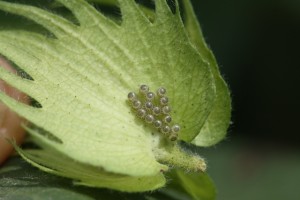Listed below are label restrictions for planting small grains following harvest aid application in cotton. Continue reading
All posts by Scott Stewart, West TN Research & Education Center
Early Defoliation Demonstrations and Activity
On August 21 a defoliation demonstration was sprayed at the entrance to the West TN Research and Education Center in Jackson. It is on the east side of the main drive about half way to the main building. Signs will be posted if you have interest in looking at the treatments. Cotton ranging from just reaching cutout to having nearly 100% open bolls is complicating defoliation decisions. Below are several scenairos to consider: Continue reading
Cotton Defoliation – Defoliating Drought Stressed Cotton
Drought-stressed cotton often has thick cuticles and leathery leaves that inhibit the uptake of many defoliants. The potential for re-growth is often high due to unused nitrogen remaining after premature cutout. Continue reading
Cotton Defoliation – Product Activity Chart
The chart below provides use pattern and expected activity for cotton defoliation products. Continue reading
Cotton Defoliation – Defoliation Products
Defoliants can be categorized as having either herbicidal or hormonal activity. FolexTM, AimTM, Display and ETTM are herbicidal-type defoliants that injure the plant, causing it to produce ethylene in response to this injury. Continue reading
Cotton Defoliation – When to Defoliate
Defoliants work best on mature cotton under warm, humid and sunny conditions. Cool temperatures prior to application and for the three to five days afterward can reduce the activity of defoliant. Continue reading

What Kind of Eggs are These?

Another bug identification quiz for you. These are the eggs of a predator which is sometimes mistaken for a pest. This species lays its eggs in a cluster. A crown of spines around the top of each egg is a good hint. Both the nymphs and adults will attack may different kinds of prey, but they are commonly seen feeding on caterpillars. They are often found in soybean and cotton. The scientific name for this species is Podisus maculiventris (Order Hemiptera; Family Pentatomidae). Still don’t know? Continue reading
Moth Trapping Data (Week Ending August 16th)
Week Ending August 16 – Corn earworm (bollworm) moth catches remained relatively high this week. As I said last week, we should have heightened awareness for this pest, especially in late maturing fields of soybean and susceptible cotton fields. Beet armyworm moth catches were well up Continue reading
